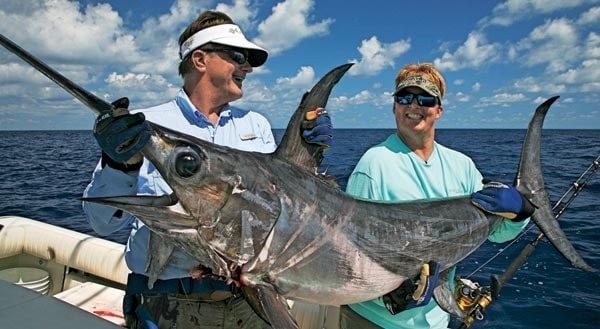
I was in a serious quandary. Given that daytime swordfishing has become world-class in south Florida over the past few years, I desperately wanted to partake in it, yet not by joining this mostly electric-reel fishing fraternity.
You see, to target these fish during the day, baits are lowered into major depressions and crevices between 1,600 and 1,900 feet down with weights as heavy as 15 pounds. It’s easy to understand the use of electric reels, as it would take a football team of guys to manually hand-crank that much line and weight up from those depths, and they’d still collapse onto the deck from exhaustion. But I don’t and won’t consider pushing a button sporting unless, of course, one’s physical challenges dictate it. What’s more, most of these electric-reel daytime sword drops are done as commercial ventures, to winch up swordfish to sell. Are there any sportsmen left in this fishery?
In my opinion, the hot ticket for not only this fishery but also for deep-dropping for grouper and tilefish is a simple electric assist device. I’m talking about a unit that taps into your boat’s power supply, attaches to your reel and provides a power assist when it’s time to bring up excessive weights from considerable distances, such as when you need to check your baits. Yet when you hook a fish, it’s just you and your tackle – minus the electrical assist.
Ask, and Ye Shall Receive
Granted, there are some quality full-blown electric reels on the market that offer the option of hand-cranking a fish when desired, most notably Diawa’s MP3000 and Dolphin Electreel fishing reels. And these are indeed great units. However, I was searching for one more twist, something that would allow me to easily put one of my existing standard big-game reel/rod outfits into play without spending thousands of dollars for an independent, full-blown electric reel/rod combo.
I mentioned all this to Carl Huffman, president of Elec-Tra-Mate and a longtime friend. I explained my intentions of shooting one of my television episodes on daytime swordfishing off Fort Lauderdale and how I wanted to do things the good old-fashioned sporting way and battle these fish with a traditional hand-cranked reel. Huffman and his design team went to work, and I was surprised at how quickly they developed a prototype for me. I had the opportunity to use the very first Elec-Tra-Mate Turn-A-Mate drive during a very important outing and while cameras were running – talk about holding your breath and hoping that all would go according to plan!
Meet the Turn-A-Mate
This unit, with a top-side grip, looks much like a large hand-held car vacuum cleaner. The 10-foot power cord connects to the same adapter I use to power my electric kite reels. When an assist was needed, I’d just pick up the 7-pound unit and attach it to the base of my Penn International 80 Wide reel handle. The connection between the motor and the reel handle was provided by a Reel Crankie, a coupling device marketed by Custom Rod & Reel in Lighthouse Point, Florida (954-781-5600). The Reel Crankie comes in several sizes; choose based on the type of reel you plan to use with it. It affixes to the Turn-A-Mate, and its opposite end
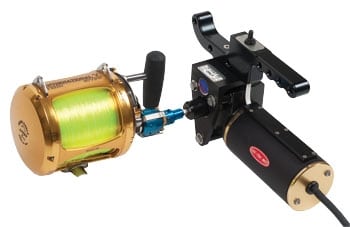
fastens to the base of the reel handle. A flip of the switch activates the Turn-A-Mate, and up comes the line. That’s basically all there is to it. Once the line has been retrieved, disengage the Crankie and you are back to manual operation.
Loves Hard Work
To get an idea of the paces this unit would be put through, you have to understand how I set up for daytime swordfish. I stripped the monofilament line off a two-speed Penn International 80 Wide reel and filled it with 65-pound. With drops to as deep as 1,900 feet, the relatively light braid serves three main purposes. Firstly, the small diameter cuts through the water and Gulf Stream current with minimum resistance; this means the bait will reach bottom faster and with less weight. Secondly, the lighter braid telegraphs the slightest tap when swordfish nearly 2,000 feet deep hit the bait. Thirdly and equally importantly, a ton of braid can be spooled onto the reel. The advantage here is that when it comes time to fight a fish or retrieve the bait, the diameter of the reel spool is still significant, which enables more line to be retrieved with each revolution of the reel handle.
Affixed to the braided line was a 100-foot, 200-pound-test wind-on monofilament leader, followed by a ball-bearing snap swivel, the actual leader (10 feet long) and the bait. The only other tackle alteration was swapping out the rod’s straight butt for a small bent-butt to keep the rod tip and braided line away from the side of the boat. Yet when it came time for me to fight a fish, it slipped into the gimbal on my rod belt and enabled me to take on a fish stand-up style.
Good Company
Capt. Steve Huddleston (954-562-0051) is one of the very best at catching swordfish both day and night, and he joined me on my outing. On this particular day, we had a calm sea and about a 2- to 3-knot Gulf Stream current over the swordfish grounds. Dropping a bait to the bottom some 1,800 feet below required a 12-pound weight. Once it was there, we took several cranks on the reel handle to lift the weight 30 to 50 feet above bottom, to avoid snags. We power-drifted over the spot, with all eyes watching the rod tip for either a slight tap or its straightening up, indicating a fish swimming upward with the bait. It didn’t take long. Huddleston and I caught four swordfish on that outing. And the Turn-A-Mate performed admirably and flawlessly!
When we attached the drive, it took 15 to 18 minutes to retrieve the line, weight and bait from 1,800 feet of water – not bad considering it required just as long to set the bait and get dialed into position. The unit was comfortable to hold, and it brought up the braid at a speed that I didn’t consider dangerous when levelwinding. When it wasn’t in use, it rested on top of the console seat, within easy reach. I have used this prototype several times since my outing with Huddleston, and it now has become the Turn-A-Mate model 570T.
**Faster Horses
**Huffman wanted to hear the negatives, which were critical to his improving the unit, and not so much the positives. The only improvement I recommended was a bit more speed. The weight of the unit was perfectly manageable, and I never tired holding it for those 15- to 18-minute retrievals. The end result is a slightly larger and heavier (20-pound) Turn-A-Mate drive model 830T. According to Elec-Tra-Mate tests, this unit retrieved a 20-pound weight from 2,000 feet of water in five minutes. Beware: When dealing with such a fast assist and attempting to lay line evenly on the spool, consider using a tool to guide the line. Should your fingers get caught under the braid, the speed and power of the assist – well, you get my drift. Not pretty.
The Sporting Way
Considering the tactics used to catch daytime swords off south Florida and how the game is rapidly spreading to other coastal states, Elec-Tra-Mate’s Turn-A-Mate 830T stands to be a hot commodity. And the smaller model, the Turn-A-Mate 570T, is well-matched to handling line for recreational deepwater grouper fishing and tilefishing, where drops are often 400 to 700 feet. Think of how easy it would be to bring up those rigs to check baits with an electric assist and how much energy you could save until it’s really needed for fighting a fish up from those depths.
These two models represent worthy pieces of tackle that go a long way toward putting the sport back into several deep and exciting fisheries while holding costs down. I wouldn’t have it any other way. But if the deepwater grouper, tilefish and swordfish could talk, I’m sure they’d have an entirely different opinion!
***
Easy as 1-2-3
Attach a Reel Crankie to the reel handle, then attach the Turn-A-Mate for easy rig retrieval:
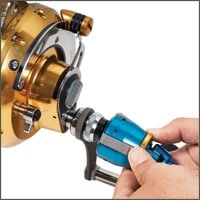
|
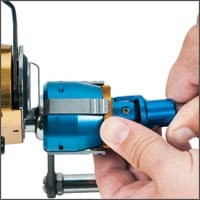
|
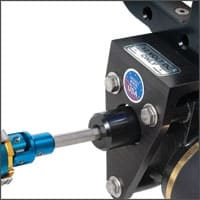
|









